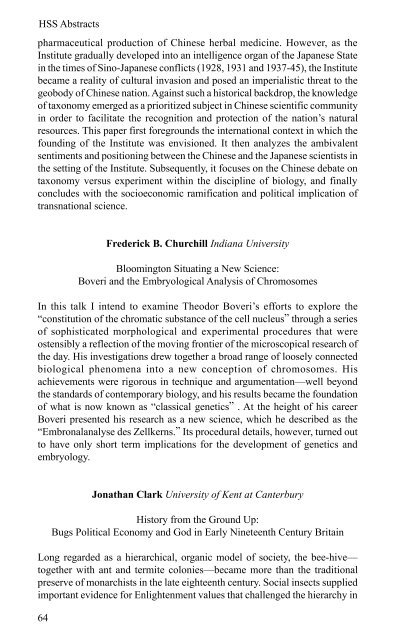2000 HSS/PSA Program 1 - History of Science Society
2000 HSS/PSA Program 1 - History of Science Society
2000 HSS/PSA Program 1 - History of Science Society
You also want an ePaper? Increase the reach of your titles
YUMPU automatically turns print PDFs into web optimized ePapers that Google loves.
<strong>HSS</strong> Abstracts<br />
pharmaceutical production <strong>of</strong> Chinese herbal medicine. However, as the<br />
Institute gradually developed into an intelligence organ <strong>of</strong> the Japanese State<br />
in the times <strong>of</strong> Sino-Japanese conflicts (1928, 1931 and 1937-45), the Institute<br />
became a reality <strong>of</strong> cultural invasion and posed an imperialistic threat to the<br />
geobody <strong>of</strong> Chinese nation. Against such a historical backdrop, the knowledge<br />
<strong>of</strong> taxonomy emerged as a prioritized subject in Chinese scientific community<br />
in order to facilitate the recognition and protection <strong>of</strong> the nation’s natural<br />
resources. This paper first foregrounds the international context in which the<br />
founding <strong>of</strong> the Institute was envisioned. It then analyzes the ambivalent<br />
sentiments and positioning between the Chinese and the Japanese scientists in<br />
the setting <strong>of</strong> the Institute. Subsequently, it focuses on the Chinese debate on<br />
taxonomy versus experiment within the discipline <strong>of</strong> biology, and finally<br />
concludes with the socioeconomic ramification and political implication <strong>of</strong><br />
transnational science.<br />
Frederick␣ B. Churchill Indiana University<br />
Bloomington Situating a New <strong>Science</strong>:<br />
Boveri and the Embryological Analysis <strong>of</strong> Chromosomes<br />
In this talk I intend to examine Theodor Boveri’s efforts to explore the<br />
“constitution <strong>of</strong> the chromatic substance <strong>of</strong> the cell nucleus” through a series<br />
<strong>of</strong> sophisticated morphological and experimental procedures that were<br />
ostensibly a reflection <strong>of</strong> the moving frontier <strong>of</strong> the microscopical research <strong>of</strong><br />
the day. His investigations drew together a broad range <strong>of</strong> loosely connected<br />
biological phenomena into a new conception <strong>of</strong> chromosomes. His<br />
achievements were rigorous in technique and argumentation—well beyond<br />
the standards <strong>of</strong> contemporary biology, and his results became the foundation<br />
<strong>of</strong> what is now known as “classical genetics” . At the height <strong>of</strong> his career<br />
Boveri presented his research as a new science, which he described as the<br />
“Embronalanalyse des Zellkerns.” Its procedural details, however, turned out<br />
to have only short term implications for the development <strong>of</strong> genetics and<br />
embryology.<br />
64<br />
Jonathan Clark University <strong>of</strong> Kent at Canterbury<br />
<strong>History</strong> from the Ground Up:<br />
Bugs Political Economy and God in Early Nineteenth Century Britain<br />
Long regarded as a hierarchical, organic model <strong>of</strong> society, the bee-hive—<br />
together with ant and termite colonies—became more than the traditional<br />
preserve <strong>of</strong> monarchists in the late eighteenth century. Social insects supplied<br />
important evidence for Enlightenment values that challenged the hierarchy in
















